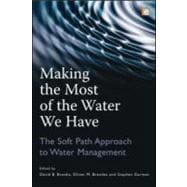
Note: Supplemental materials are not guaranteed with Rental or Used book purchases.
Purchase Benefits
What is included with this book?
| List of Figures, Tables and Boxes | p. ix |
| List of Contributors | p. xi |
| Foreword | p. xv |
| Acknowledgements | p. xix |
| List of Acronyms and Abbreviations | p. xxi |
| Introduction | |
| Why a Water Soft Path, and Why Now | p. 3 |
| Water Soft Paths as Human Vision | |
| Avoiding the Perfect Storm: Weathering Climate Change by Following its Effects on Water Resources | p. 23 |
| In the Beginning: Soft Energy Paths | p. 35 |
| Gestting it Right: Misconceptions About the Soft Path | p. 49 |
| Practising Ecological Governance: The Case for the Soft Path for Water | p. 61 |
| Water Policy: Changing Course for the Soft Path | p. 73 |
| Water Soft Paths as Analytical Method | |
| Getting Quantitative: The Canadian Water Soft Path Studies | p. 85 |
| Turning Principles into Practice: The WSP Scenario Builder | p. 101 |
| Thinking Beyond Pipes and Pumps: Water Soft Paths at the Urban Scale | p. 113 |
| Focusing on Geographic Boundaries: Water Soft Paths at the Watershed Scale | p. 123 |
| Focusing on Political Boundaries: Water Soft Paths at the Provincial Scale | p. 133 |
| Water Soft Paths as Planning Tool | |
| Removing Institutional Barriers to Water Soft Paths: Challenges and Opportnnities | p. 147 |
| pushing the Boundaries: Shifting Water Soft Paths Philosophy towards Hard Policy in Municipal Water Management | p. 163 |
| Green Buildings and Urban Space: A Water Soft Path Perspective | p. 181 |
| Water Soft Path Thinking in the United States | p. 195 |
| Water Soft Path Thinking in Other Developed Economies | p. 205 |
| Editor's Note | p. 205 |
| A England | p. 206 |
| BThe European Union | p. 211 |
| C Australia | p. 218 |
| Water Soft Path Thinking in Developing Countries | p. 227 |
| Editor's Note | p. 227 |
| A South Africa | p. 228 |
| BIndia | p. 234 |
| CMiddle East and North Africa | p. 242 |
| Conclusion | |
| A Water Future Different from the Past | p. 255 |
| Annex-How To Create A Soft Path Plan For Water | p. 267 |
| Index | p. 267 |
| Table of Contents provided by Ingram. All Rights Reserved. |
The New copy of this book will include any supplemental materials advertised. Please check the title of the book to determine if it should include any access cards, study guides, lab manuals, CDs, etc.
The Used, Rental and eBook copies of this book are not guaranteed to include any supplemental materials. Typically, only the book itself is included. This is true even if the title states it includes any access cards, study guides, lab manuals, CDs, etc.